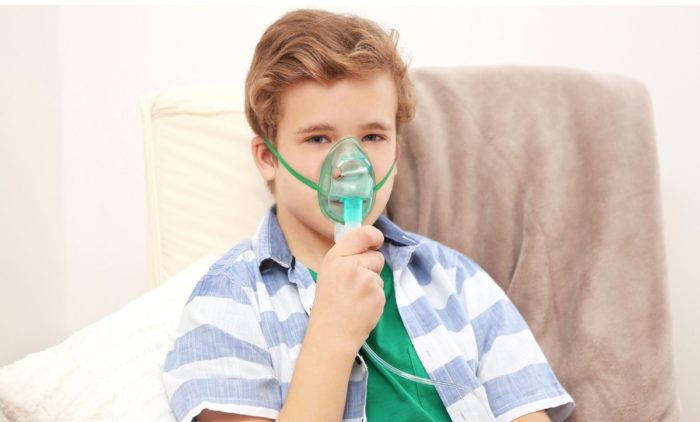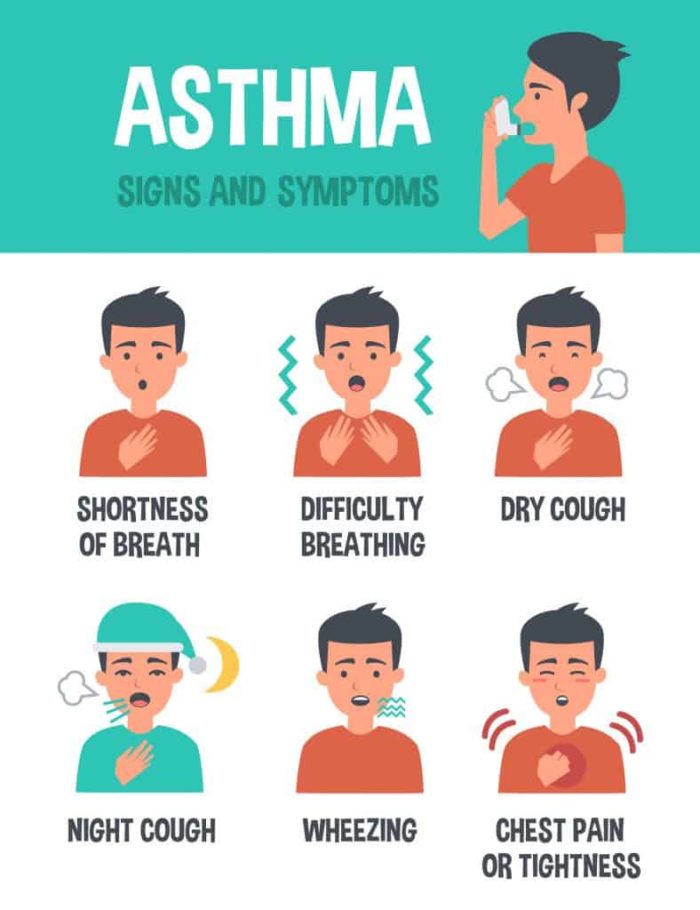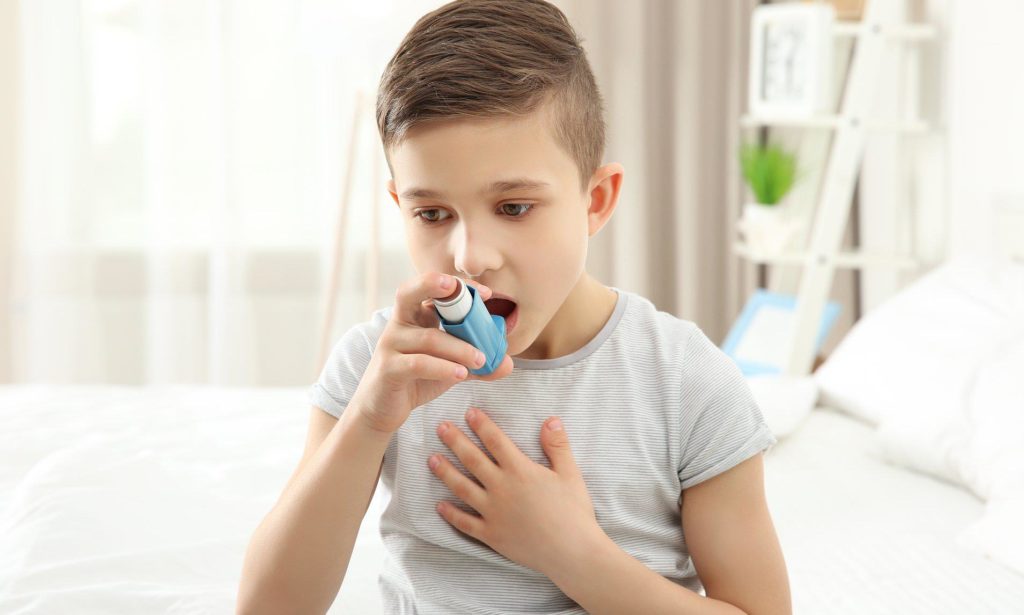Childhood asthma, a respiratory condition that afflicts millions of children around the globe, is an enigmatic ailment. The airways clog and swell with inflammation, causing troubled breathing and other perplexing symptoms. The affliction’s severity ranges from mild to severe, with triggers as varied as the colors of a rainbow.

Coughing fits, wheezing spells, shortness of breath – these are just some of the abrupt bursts that can plague asthmatic children. Chest tightness or pain may accompany these sudden attacks which could last for hours or disappear in spurts over time. If your little one suffers from any such spell frequently enough to give you pause, it’s crucial to seek swift medical assistance.
The causes behind childhood asthma remain shrouded in mystery but experts believe genetic and environmental factors play key roles. Allergens like pollen or dust mites; irritants akin to cigarette smoke or pollution; viral infections; exercise-induced stressors – all contribute to this complex puzzle. A correct diagnosis becomes imperative before embarking on a treatment plan tailored specifically for your child’s needs. This might necessitate allergy tests or lung function evaluations administered by healthcare professionals who will devise an action plan involving parents/guardians/teachers/school nurses so they are well-equipped should an attack occur including medication administration etc…
Identifying Asthma Symptoms in Children
Inexplicable and confounding, asthma is a widespread affliction that impacts a plethora of children across the globe. It behooves parents to be adept at discerning the telltale symptoms of this condition in their progeny to enable them to procure appropriate treatment and manage their child’s state efficaciously.

A cough that persists persistently, particularly at night or early morning, is one of the most prevalent manifestations of childhood asthma. Should your offspring suffer from such an ailment for more than a week or two, it may well indicate an onset of childhood asthma. Additional indicators include wheezing, shortness of breath and tightness in the chest.
It bears emphasizing that not all asthmatic children experience identical symptoms. While some endure intermittent flare-ups only sporadically, others may contend with chronic indications that necessitate constant medication administration and meticulous adherence to an asthma action plan. Identifying triggers like allergies or physical exertion can help preempt an asthmatic attack while facilitating effective treatment for pediatric asthma management purposes.
Causes of Childhood Asthma
In a perplexing twist of fate, children with a familial history of asthma are more prone to developing the ailment themselves. Furthermore, the tender age of younger kids renders them even more susceptible to contracting this malady due to their nascent immune systems. The symptoms that often rear their ugly head include wheezing, coughing fits and shortness of breath.
It is crucial that asthma is identified in its embryonic stages so that appropriate treatment can be initiated posthaste. Asthma medication not only manages the symptoms but also forestalls attacks from happening altogether. In case your child suffers an asthma attack, it is imperative that medical aid is sought without delay.
The mitigation process for your offspring’s asthma includes taking steps towards averting future bouts as well as providing relief during occurrences thereof. This necessitates identifying triggers such as allergens or exercise and avoiding them where possible. If diagnosed with asthma, regular check-ups are indispensable with either a doctor or specialist.
Ignoring signs indicative of an impending asthmatic episode can quickly escalate into life-threatening situations if left unattended to promptly. Henceforth it behooves parents to educate themselves on how best they can discern these telltale signs and what actions need be taken when faced with emergencies arising therefrom. By grasping childhood asthma and implementing requisite precautions accordingly, you enable your child’s good health despite being plagued by this commonplace childhood affliction.\n
Diagnosing Asthma in Children
The intricacies of detecting asthma in children can be elusive, as symptoms may not manifest until exposure to triggers. Nevertheless, it behooves parents to remain vigilant of their child’s breathing patterns and any anomalies that surface. If your little one undergoes wheezing, shortness of breath or coughing fits exacerbated by nocturnal or physical activity, seeking medical guidance is imperative.
It’s a daunting fact that half of children diagnosed with respiratory ailments before the tender age of 3 are afflicted with asthma. To diagnose and manage this condition effectively necessitates close collaboration between parents and healthcare providers. While there is no permanent cure for asthma, treatments exist that aid symptom control and thwart future attacks.
Following diagnosis, creating an individualized plan tailored to your child is crucial. This blueprint should enumerate treatment options along with measures you can take at home if an attack ensues. It should also specify medication administration frequency while instructing on what steps must be taken if symptoms intensify. By adhering strictly to this blueprint, you can help regulate your child’s asthma while preventing its onset altogether.
Treating Asthma in Children
In the perplexing world of childhood asthma treatment, identifying and dodging triggers is a fundamental step. These triggers can range from allergens to pollution, smoke, and even exercise. By limiting exposure to these elusive culprits, children with asthma may experience fewer symptoms and lead an enhanced quality of life.
Not only that, but parents must also be alert to the signs and symptoms of asthma so they can act fast when their child undergoes an attack. The telltale indicators include wheezing, coughing fits, chest tightness or pain, shortness of breath – all leading up to breathing difficulty. But beware: not all asthmatic kids will display these warning signs at all times; some might only show them during physical activity or when facing specific triggers.
It’s important to realize that various types of asthma exist for different age groups in children. For instance, younger ones are more prone to allergic manifestations while older ones may encounter non-allergic forms. Standard treatments for childhood asthma typically comprise medication (such as inhalers) along with lifestyle changes (like evading triggers). Asthma management plans should be customized according to each child’s unique needs in order to effectively decrease their risk of experiencing another debilitating attack.
Managing Your Child’s Asthma
The enigmatic and explosive world of childhood asthma demands that parents fathom its symptoms and causes. Amongst the most prevalent illnesses afflicting children, asthma often takes root in early life. Akin to a genetic inheritance or an environmental scourge like air pollution, certain factors can increase your child’s likelihood of developing this inscrutable ailment.
If your child has been diagnosed with asthma, unraveling its mysteries is paramount. Adequate treatment and management entail regular visits to an asthma specialist, adhering meticulously to prescribed medications, and mastering breathing exercises and other techniques for controlling it.
A key tenet of managing childhood asthma is keeping symptoms at bay by detecting incipient signs such as coughing fits, wheezing episodes, labored breathing or chest tightness. By collaborating closely with a healthcare provider who tailors a personalized treatment plan targeting specific symptoms whilst thwarting triggers from unleashing attacks; you’ll be able to foster your child’s wellbeing so they remain sprightly and robust.
Preventing Asthma Attacks in Children
The enigma of asthma in children is a perplexing one. It’s a respiratory ailment that can cause suffocating breathing difficulties. Managing this condition demands the prevention of asthma attacks, which is no mean feat. The first step towards safeguarding your child from an attack is to diagnose them accurately. This requires continuous monitoring of their daily symptoms and consulting with healthcare professionals who possess the expertise needed to determine if these discomforts are caused by asthma.
Once diagnosed, developing an action plan for your child becomes imperative as it serves as a crucial guide on what steps to take when symptoms worsen or warning signs manifest. This blueprint highlights how to alleviate symptoms and when emergency medical attention should be sought – critical information for both parents and older children alike.
It behooves parents always to remain alert for signs of severe attacks because time is of the essence when dealing with such emergencies. These signal flares could include difficulty breathing, rapid breathing or wheezing, chest pain or tightness, persistent coughing despite medication intake, and trouble speaking due to shortness of breath.
If any such signals appear despite home treatment efforts, do not hesitate; seek immediate medical attention since any delay may prove fatal.
In summing up this discourse on managing childhood asthma effectively: Consistency is key! Ensuring that your child follows their prescribed treatment regimen faithfully will go a long way in preventing exacerbations caused by this chronic condition ultimately resulting in healthy living free from distressful asthmatic episodes!
Important Information for Parents of Children with Asthma
The perplexing reality of asthma in children demands attention. The burstiness of symptoms can range from a wheezing cough to difficulty breathing, causing great concern for parents. Understanding the intricacies of this illness and its diverse manifestations is crucial to identifying an attack.
Physical exertion and nocturnal hours exacerbate the already unpredictable nature of childhood asthma. Yet, there are potential triggers that could spark a sudden outburst, such as dust mites or pollen exposure. It’s imperative to detect these catalysts to thwart future attacks.
Failure to address asthmatic conditions could lead down a treacherous path towards severe health complications. Treatment modalities vary depending on the gravity of each child’s situation and their unique needs; inhalers or nebulizers with prescribed medication may be viable options. Regular check-ups with healthcare professionals remain paramount in mitigating asthma’s impact and preventing further debilitation from occurring.

